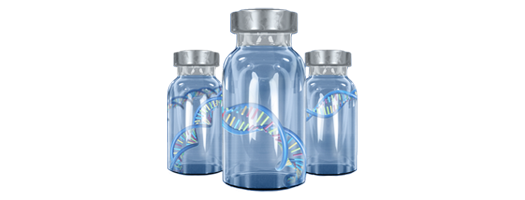What is Armored Molecular Control Technology?
Armored Molecular Control technology involves encapsulating specific nucleic acid targets within a bacteriophage protein coat to create a virus-like particle resistant to nuclease degradation. They can be used to monitor the entire molecular testing workflow as extraction controls, process quality controls, or positive diagnostic reference controls. The RNA or DNA can be extracted from the viral coat protein either by extracting alongside test specimens or by incubating at 75°C for 3-5 minutes to release the nucleic acid from the particles.
Armored Molecular Controls are quantified using a NIST-traceable phosphate assay prior to formulation and fill. Catalog products are then tested via PCR to verify the integrity and identity of the material; custom Armored controls can also be verified by qPCR or dPCR upon request. Care should be taken with direct comparison to other reference material that has been quantified in a different manner.
Storage & Handling
- Armored controls should be kept at -20°C for long-term storage. Long term storage at -80°C is not recommended.
- Upon thawing, the material should be distributed into aliquots immediately or returned to -20°C storage.
- Avoid more than 5 freeze-thaw cycles of Armored controls.
- If dilutions need to be made, it is recommended to use TSMIII Buffer (10 mM Tris, 100 nM NaCl, 1 mM MgCl2, 0.1% Gelatin, 0.3% Microcide III, pH 7.0). Do NOT use water.
- Never vortex Armored controls.

For Use as an Extraction Control
- Thaw the Armored controls on ice. It is important to allow each vial to thaw completely, gently tap to mix (do not vortex) and pulse spin. Aliquot as necessary.
- Perform any dilutions using TSMIII buffer. Invert to mix, do not vortex.
- Add Armored controls into negative matrix or lysis buffer of choice. When adding to negative matrix, invert to mix, do not vortex.
- For Armored RNA controls – it is recommended to avoid treatments to remove genomic DNA as these controls do not have any DNA.
- For optimal recovery, it is advised to use a viral extraction kit that includes carrier RNA or DNA.
- Proceed with analysis alongside patient samples.
For Use as a Positive Control
- Thaw the Armored controls on ice. It is important to allow each vial to thaw completely, gently tap to mix (do not vortex), and pulse spin prior to heating.
- It is also important to heat-denature and cool the control immediately prior to the RT-PCR or PCR. Aliquot as necessary.
- Perform any dilutions using TSMIII buffer.
- Heat-lyse by heating at 75°C for 3-5 minutes. Ensure lysis tubes make complete contact with heat block wells and temperature is confirmed with a validated thermometer.
- Allow materials to equilibrate to room temperature for 5 minutes or place on ice. Gently tap to mix (do not vortex) and pulse spin.
- Proceed with analysis alongside patient samples.
Stability of Armored RNA®
- Catalog Armored molecular control products have exhibited real-time stability up to 36 months when stored at -20°C and up to 12 months at +4°C when formulated in TSMIII.
- Additional studies have been done on several constructs to demonstrate stability in plasma at 4°C for up to 28 weeks.
- Custom Armored controls should be tested on an individual basis to determine shelf life. Accelerated stability studies can provide data required to bridge the time frame from when a real time study is initiated to its completion; custom stability evaluation services are available upon request.
Watch the Video to Learn More about Stable, Non-Infectious, and Customizable Armored Control Process
Custom Molecular Controls
With a cGMP manufacturing facility governed by our ISO 13485 certified quality system, we can provide customized target Armored RNA® and Armored DNA® as well as custom multiplexed panels. Extensive quality control measures support products derived from any step of the manufacturing process, including plasmid DNA (circular or linearized) and in vitro transcribed RNA. Custom targets are available in three different grades: evaluation, development, and cGMP.
Delivering custom design, reliable service, and seamless integration for molecular diagnostic manufacturers

